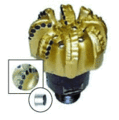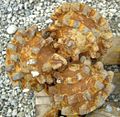- Drill bit (well)
-
A Drill bit, is a device attached to the end of the drill string that breaks apart, cuts or crushes the rock formations when drilling a wellbore, such as those drilled to extract water, gas, or oil.
The drill bit is hollow and has jets to allow for the expulsion of the drilling fluid, or "mud", at high velocity and high pressure to help clean the bit and, for softer formations, help to break apart the rock. A tricone bit comprises three conical rollers with teeth made of a hard material, such as tungsten carbide. The teeth break rock by crushing as the rollers move around the bottom of the borehole. A polycrystalline diamond compact (PDC) bit has no moving parts and works by scraping the rock surface with disk-shaped teeth made of a slug of synthetic diamond attached to a tungsten carbide cylinder.
The tricone bit is an improvement on the original bit patented in 1909 by Howard R. Hughes, Sr. of Houston, Texas,[1] father of the famed billionaire Howard R. Hughes, Jr..
PDC bits, first came into widespread use in 1976, used for gas and oil exploration the North Sea. They are effective at drilling shale formations, especially when used in combination with oil-base drilling muds.
See also
Drilling rig (petroleum) — diagram of a drilling rig
References
- ^ See U.S. Patent 930,758
Categories:- Petroleum stubs
- Oilfield terminology
- Drilling technology
Wikimedia Foundation. 2010.






